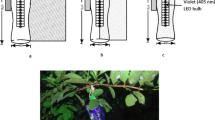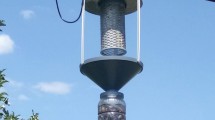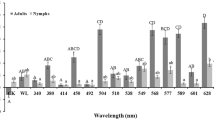Abstract
Light traps have been widely used for controlling underground pests. However, very little is known regarding the relationship between trapping effect and antioxidant enzymatic activities using light irradiation in underground pests. Thus, we determined the trapping effect of three light sources of the frequoscillation pest-killing lamp on two species of cockchafers, Serica orientalis Motschulsky (Coleoptera: Melolonthidae) and Anomala corpulenta Motschulsky (Coleoptera: Rutelidae), and evaluated the effect of the same three light sources on the activities of their antioxidant enzymes. The catches of S. orientalis were significantly higher compared to A. corpulenta using light source A in peanut fields in China. After irradiation by light source A, the malondialdehyde (MDA) contents and activities of superoxide dismutase (SOD) and glutathione S-transferases (GST) in S. orientalis were significantly and marginally significantly lower compared to A. corpulenta. Taken together, these results indicated a weaker antioxidant enzyme activity response to light stress and a larger quantity of trapping catches using light irradiation in cockchafers. Thus, we proposed a potential negative relationship between trapping effect and antioxidant enzymatic activities in response to light irradiation in cockchafers.





Similar content being viewed by others
References
A-H-Mackerness S, Surplus SL, Blake P, John CF, Buchanan-Wollaston V, Jordan BR, Thomas B (1999) Ultraviolet-B-induced stress and changes in gene expression in Arabidopsis thaliana: role of signalling pathways controlled by jasmonic acid, ethylene and reactive oxygen species. Plant Cell Environ 22:1413–1423
Ahmad S (1992) Biochemical defence of pro-oxidant plant allelochemicals by herbivorous insects. Biochem Syst Ecol 20:269–296
Ahmad S, Duval DL, Weinhold LC, Pardini RS (1991) Cabbage looper antioxidant enzymes: tissue specificity. Insect Biochem 21:563–572
Allsopp PG (2010) Integrated management of sugarcane whitegrubs in Australia: an evolving success. Annu Rev Entomol 55:329–349
Atkins MD (1980) Introduction to insect behaviour. Macmillan Publishing Co. Inc., New York
Baker RR, Sadovy Y (1978) The distance and nature of the light-trap response of moths. Nature 276:818–821
Bradford MM (1976) A rapid and sensitive method for the quantification of microgram quantities of protein utilizing the principle of protein dye binding. Anal Biochem 72:248–254
Callahan PS (1965a) Intermediate and far infrared sensing of nocturnal insects. Part I. Evidences for a far infrared (FIR) electromagnetic theory of cummunication and sensing in moths and its relationship to the limiting biosphere of the corn earworm. Ann Entomol Soc Am 58:727–745
Callahan PS (1965b) Intermediate and far infrared sensing of nocturnal insects. Part II. The compound eye of the corn earworm, Heliothis zea, and other moths as a mosaic optic-electromagnetic thermal radiometer. Ann Entomol Soc Am 58:746–756
Del Rio D, Stewart AJ, Pellegrini N (2005) A review of recent studies on malondialdehyde as toxic molecule and biological marker of oxidative stress. Nutr Metab Cardiovasc 15:316–328
Dubovskiy IM, Martemyanov VV, Vorontsova YL, Rantala MJ, Gryzanova EV, Glupov VV (2008) Effect of bacterial infection on antioxidant activity and lipid peroxidation in the midgut of Galleria mellonella L. larvae (Lepidoptera, Pyralidae). Comp Biochem Physiol C 148:1–5
Felton GW, Summers CB (1995) Antioxidant systems in insects. Arch Insect Biochem 29:187–197
Fridovich I (1978) The biology of oxygen radicals. Science 201:875–880
Gao XM, Jia FX, Shen GM, Jiang HQ, Dou W, Wang JJ (2013) Involvement of superoxide dismutase in oxidative stress in the oriental fruit fly, Bactrocera dorsalis: molecular cloning and expression profiles. Pest Manag Sci 69:1315–1325
Gunn A (1998) The determination of larval phase coloration in the African armyworm Spodoptera exempta and its consequences for thermoregulation and protection from UV light. Entomol Exp Appl 86:125–133
Heck DE, Vetrano AM, Mariano TM, Laskin JD (2003) UVB light stimulates production of reactive oxygen species: unexpected role for catalase. J Biol Chem 278:22432–22436
Jing XF, Lei CL (2004) Advances in research on phototaxis of insects and the mechanism. Entomol Knowl 41:198–203
Jing XF, Luo F, Zhu F, Huang QY, Lei CL (2005) Effects of different light source and dark-adapted time on phototactic behavior of cotton bollworms (Helicoverpa armigera). Chinese. J Appl Ecol 16:586–588
Jones G (1990) Prey selection by the greater horseshoe bat (Rhinolophus ferrumequinum): optimal foraging by echolocation? J Anim Ecol 59:587–602
Kono Y, Shishido T (1992) Distribution of glutathione S-transferase activity in insect tissues. Appl Entomol Zool 27:391–397
Krishnan N, Kodrík D (2006) Antioxidant enzymes in Spodoptera littoralis (Boisduval): are they enhanced to protect gut tissues during oxidative stress? J Insect Physiol 52:11–20
Lopez-Martinez G, Elnitsky MA, Benoit JB, Lee JRE, Denlinger DL (2008) High resistance to oxidative damage in the Antarctic midge Belgica antarctica, and developmentally linked expression of genes encoding superoxide dismutase, catalase and heat shock proteins. Insect Biochem Mol 38:796–804
Mazza CA, Izaguirre MM, Zavala J, Scopel AL, Ballaré CL (2002) Insect perception of ambient ultraviolet-B radiation. Ecol Lett 5:722–726
Meng JY, Zhang CY, Zhu F, Wang XP, Lei CL (2009) Ultraviolet light-induced oxidative stress: effects on antioxidant response of Helicoverpa armigera adults. J Insect Physiol 55:588–592
Meng JY, Zhang CY, Lei CL (2010) A proteomic analysis of Helicoverpa armigera adults after exposure to UV light irradiation. J Insect Physiol 56:405–411
Neethirajan S, Karunakaran C, Jayas DS, White NDG (2007) Detection techniques for stored-product insects in grain. Food Control 18:157–162
Rebollar E, Valadez-Graham V, Vázquez M, Reynaud E, Zurita M (2006) Role of the p53 homologue from Drosophila melanogaster in the maintenance of histone H3 acetylation and response to UV-light irradiation. FEBS Lett 580:642–648
Robinson HS (1952) On the behaviour of night-flying insect in the neighbourhood of a bright source of light. P Roy Entomol Soc A 27:13–21
Robinson HS, Robinson PJM (1950) Some notes on the observed behaviour of Lepidoptera in flight in the vicinity of light-sources, together with a description of a light-trap designed to take entomological samples. Ent Gaz 1:3–20
Sang W, Ma WH, Qiu L, Zhu ZH, Lei CL (2012) The involvement of heat shock protein and cytochrome P450 genes in response to UV-A exposure in the beetle Tribolium castaneum. J Insect Physiol 58:830–836
Schauen M, Hornig-Do HT, Schomberg S, Herrmann G, Wiesner RJ (2007) Mitochondrial electron transport chain activity is not involved in ultraviolet A (UVA)-induced cell death. Free Radic Biol Med 42:499–509
Shigeoka S, Ishikawa T, Tamoi M, Miyagawa Y, Takeda T, Yabuta Y, Yoshimura K (2002) Regulation and function of ascorbate peroxidase isoenzymes. J Exp Bot 53:1305–1319
Švestka M (2007) Ecological conditions influencing the localization of egg-laying by females of the cockchafer (Melolontha hippocastani F.) J For Sci 53:16–24
Wang Y, Oberley LW, Murhammer DW (2001) Antioxidant defense systems of two lepidopteran insect cell lines. Free Radic Biol Med 30:1254–1262
Wang Y, Wang LJ, Zhu ZH, Ma WH, Lei CL (2012) The molecular characterization of antioxidant enzyme genes in Helicoverpa armigera adults and their involvement in response to ultraviolet-A stress. J Insect Physiol 58:1250–1258
Wood BJ, Yew NK (1969) The cockchafer, Psilopholis vestita, a new pest of oil palms in West Malaysia. Planter 45:577–586
Yang LH, Huang H, Wang JJ (2010) Antioxidant responses of citrus red mite, Panonychus citri (McGregor) (Acari: Tetranychidae), exposed to thermal stress. J Insect Physiol 56:1871–1876
Zhang QH, Ma JH, Yang QQ, Byers JA, Klein MG, Zhao FY, Luo YQ (2011) Olfactory and visual responses of the long-legged chafer Hoplia spectabilis Medvedev (Coleoptera: Scarabaeidae) in Qinghai Province, China. Pest Manag Sci 67:162–169
Zhou LJ, Zhu ZH, Liu ZX, Ma WH, Desneux N, Lei CL (2013) Identification and transcriptional profiling of differentially expressed genes associated with response to UVA radiation in Drosophila melanogaster (Diptera: Drosophilidae). Mol Ecol Evol 42:1110–1117
Acknowledgements
The authors thank Long Liu for his valuable assistance with the cockchafer collections. We thank Drs. Xiangfeng Jing, Changyu Zhang, Jianyu Meng, and Zhenyu Zhang for the help with the manuscript revision. We also thank the anonymous reviewers for providing valuable comments on earlier drafts of this manuscript.
Funding
This study was supported by the National Department Public Benefit (Agriculture) Research Foundation (201003025) and The National Key Research and Development Program of China (2017YFD0200906).
Author information
Authors and Affiliations
Corresponding author
Additional information
Responsible editor: Philippe Garrigues
Rights and permissions
About this article
Cite this article
Gao, Y., Li, G., Li, K. et al. Comparison of the trapping effect and antioxidant enzymatic activities using three different light sources in cockchafers. Environ Sci Pollut Res 24, 27855–27861 (2017). https://doi.org/10.1007/s11356-017-0388-1
Received:
Accepted:
Published:
Issue Date:
DOI: https://doi.org/10.1007/s11356-017-0388-1




